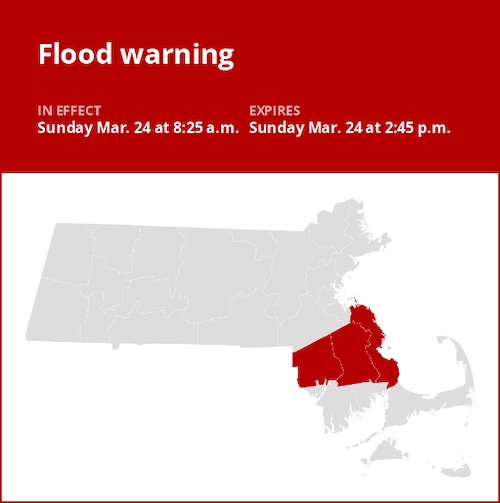On Sunday at 2:36 a.m. the National Weather Service issued a flood warning valid for Sunday between 8 a.m. and 2:45 p.m. for Bristol and Plymouth counties.
The weather service adds, “Minor flooding is forecast.”
“At 9.0 feet, Backwater flooding from the Taunton River will cause flooding of lower Purchade Brook in Middleboro. This will cause Woloski Park to become impassable by most vehicles for an extended period of time. Beware of the dangers of crossing flooded roadways. The water may be deeper than you think. Floodwaters have the ability to damage roadways. Heed the advice of local officials, and evacuate if asked to do so,” comments the weather service. “Turn around, don’t drown when encountering flooded roads. Most flood deaths occur in vehicles. The next statement will be issued this afternoon at 2:45 p.m.”

Breaking down weather alerts: advisories, watches, and warnings
- Flash flood warning: Take action!
A flash flood warning is issued when a flash flood is either imminent or already occurring. In flood-prone areas, it’s crucial to move immediately to higher ground. A flash flood is a sudden and violent inundation that can develop within minutes to hours, and it can even happen in areas not currently experiencing rainfall.
- Flood warning: Take action!
A flood warning is issued when flooding is imminent or occurring.
- Flood advisory: Be aware:
A flood advisory is issued when flooding is not expected to be bad enough to issue a warning. However, it may cause significant inconvenience, and if caution is not exercised, it could lead to situations that may threaten life and/or property.
- Flood watch: Be prepared:
A flood watch is issued when conditions are favorable for flooding. It does not mean flooding will occur, but it is possible.
Navigating floods: weather service flood safety guidelines for weathering the storm
Floods can pose a significant threat, especially if you live in a flood-prone area or find yourself camping in a low-lying region. To ensure your safety, the weather service offers essential flood safety guidelines:
1. Seek higher ground:
- If you reside in a flood-prone region or are camping in low-lying terrain, the first step to safety is relocating to higher ground.
2. Follow evacuation orders:
- If local authorities issue an evacuation order, heed it promptly. Prior to leaving, secure your home by locking it.
3. Disconnect utilities and appliances:
- If time permits, disconnect your utilities and appliances. This precaution minimizes electrical hazards during flooding.
4. Steer clear of flooded basements and submerged areas:
- Avoid basements or rooms submerged in water with electrical outlets or cords. Preventing electrical accidents is crucial.
5. Evacuate promptly for safety:
- If you notice sparks or hear buzzing, crackling, snapping, or popping sounds, evacuate without delay. Do not enter water that may carry an electrical charge.
6. Stay away from floodwaters:
- Never attempt to walk through floodwaters, even if they appear shallow. Just 6 inches of fast-moving water can forcefully sweep you off your feet.
7. Seek high ground if trapped:
- In the event you become trapped by moving water, make your way to the highest point available and contact emergency services by calling 911.
During heavy rainfall, there is a risk of flooding, especially in low-lying and flood-prone areas. Remember to never drive through water on the road, even if it seems shallow. According to the NWS, as little as 12 inches of rapidly flowing water can carry away most cars. Stay safe by being prepared and informed.
Navigating rainy roads: Safety tips for wet weather
Rain can turn roads into hazards. Stay informed and follow these weather service tips to ensure safety during heavy rainfall:
Beware of rapid water flow:
- Avoid parking or walking in close proximity to culverts or drainage ditches, as the swiftly moving water during heavy rain can potentially carry you away.
Maintain safe driving distances:
- Use the two-second rule to maintain a safe distance from the car in front of you and allow an extra two seconds in heavy rain.
Reduce speed and drive cautiously:
- On wet roads, slowing down is paramount. Gradually ease off the accelerator and avoid abrupt braking to prevent skidding.
Choose your lane wisely:
- Stick to the middle lanes on multi-lane roads to minimize the risk of hydroplaning, as water tends to accumulate in outer lanes.
Prioritize visibility:
- Turn on your headlights and be careful of other vehicles to the rear and in blind spot areas as they are especially difficult to see through rain-spattered windows.
Watch out for slippery roads:
- The initial half-hour of rain is when roads are slickest due to a mixture of rain, grime, and oil. Exercise heightened caution during this period.
Keep a safe distance from large vehicles:
- Don’t follow large trucks or buses too closely. The spray created by their large tires reduces your vision. Take care when passing them as well; if you must pass, do so quickly and safely.
Mind your windshield wipers:
- Heavy rain can overload the wiper blades. When visibility is so limited that the edges of the road or other vehicles cannot be seen at a safe distance, it is time to pull over and wait for the rain to ease up. It is best to stop at rest areas or other protected areas.
- If the roadside is your only option, pull off as far as possible, preferably past the end of a guard rail, and wait until the storm passes. Keep your headlights on and turn on emergency flashers to alert other drivers of your position.
In the face of heavy rain, these precautions can make a significant difference in ensuring your safety on the road. Remember to stay informed about weather conditions and heed guidance from local authorities for a secure journey.
Advance Local Weather Alerts is a service provided by United Robots, which uses machine learning to compile the latest data from the National Weather Service.





